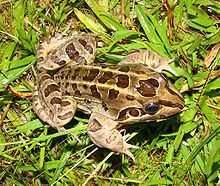Leptodactylus latrans
| Leptodactylus latrans | |
|---|---|
 | |
| Conservation status | |
| Scientific classification | |
| Kingdom: | Animalia |
| Phylum: | Chordata |
| Class: | Amphibia |
| Order: | Anura |
| Family: | Leptodactylidae |
| Genus: | Leptodactylus |
| Species: | L. latrans |
| Binomial name | |
| Leptodactylus latrans (Steffen, 1815) | |
| Synonyms | |
|
Leptodactylus macrosternum Miranda-Ribero, 1926 | |
Leptodactylus latrans is a species of frog in the Leptodactylidae family.[1] Its local name is Sapo-Rana Llanero ("Llanos toad-frog") or Rana Criolla ("Creole frog"); In Brazil it is known as Rã Manteiga ("Butter Frog"); the latter term is also used for congeners elsewhere. It is found in Argentina, Bolivia, Brazil, Colombia, French Guiana, Guyana, Paraguay, Suriname, Trinidad and Tobago, Uruguay, Venezuela, and possibly Peru. Its natural habitats are subtropical or tropical dry forests, subtropical or tropical moist lowland forests, dry savanna, moist savanna, subtropical or tropical dry shrubland, subtropical or tropical moist shrubland, temperate grassland, subtropical or tropical dry lowland grassland, subtropical or tropical seasonally wet or flooded lowland grassland, rivers, intermittent rivers, shrub-dominated wetlands, swamps, intermittent freshwater lakes, freshwater marshes, intermittent freshwater marshes, freshwater springs, pastureland, rural gardens, urban areas, heavily degraded former forest, ponds, seasonally flooded agricultural land, and canals and ditches. It is threatened by habitat loss.
General:
These frogs are frequently found resting at the margin of ponds or small lakes and jump into the water if they are perturbed. They are good swimmers but may also walk and run over land; the toe fringes they have allow for both activities. The average female size is 80-110mm and the average male length is 90-120mm. It is not exactly known how long the L. ocellatus lives however it generally seems to average around 4 – 15 years.
Diet:
The L. ocellatus are carnivorous and their diet consists mostly of small insects and larvae. They catch these insects with their tongue.
Breeding:
Breeding time is between September and February. Males climb onto the females back and beat glandular secretions of the female into a foamy mass, which creates a nest for the thousands of small black eggs. A usual nest is between 12 and 25 cm in diameter and often has a central hole of 4 to 8 cm width. The foamy mass floats on the water surface and the foam lowers the risk of attacks from predators. Females are often found sitting in the nest hole with their head poking out or beneath the nest and show threatening behaviors towards any predators that may come. After larvae hatch they swim around less than 1m away from the mother.
References
- ↑ Lavilla, Langone, Caramaschi, Heyer & de Sá, 2010 : The identification of Rana ocellata Linnaeus, 1758. Nomenclatural impact on the species currently known as Leptodactylus ocellatus (Leptodactylildae) and Osteopilus brunneus (Gosse, 1851)(Hylidae). Zootaxa, n. 2346, pag.1–16.
Bogart, J. P. (1974). A karyosystematic study of frogs in the genus Leptodactylus (Anura: Leptodactylidae). Copeia, (3), 728–737. Heyer, W. R. (1969). The adaptive ecology of the species groups of the Genus Leptodactylus (Amphibia, Leptodactylidae). Evolution, 23, 421–428.
Prado, C. P. de A., Uetanabaro, M., Haddad, C F. B. (2002). Description of a new reproductive mode in Leptodactylus (Anura, Leptodactylidae), with a review of the reproductive specialization towards terrestriality in the genus. Copeia, 2002(4), 221–245.
- Heyer, R., Langone, J., La Marca, E., Azevedo-Ramos, C., di Tada, I., Baldo, D., Lavilla, E., Scott, N., Aquino, L. & Hardy, J. 2004. Leptodactylus ocellatus. 2006 IUCN Red List of Threatened Species. Downloaded on 22 July 2007.
| Wikimedia Commons has media related to Leptodactylus latrans. |
